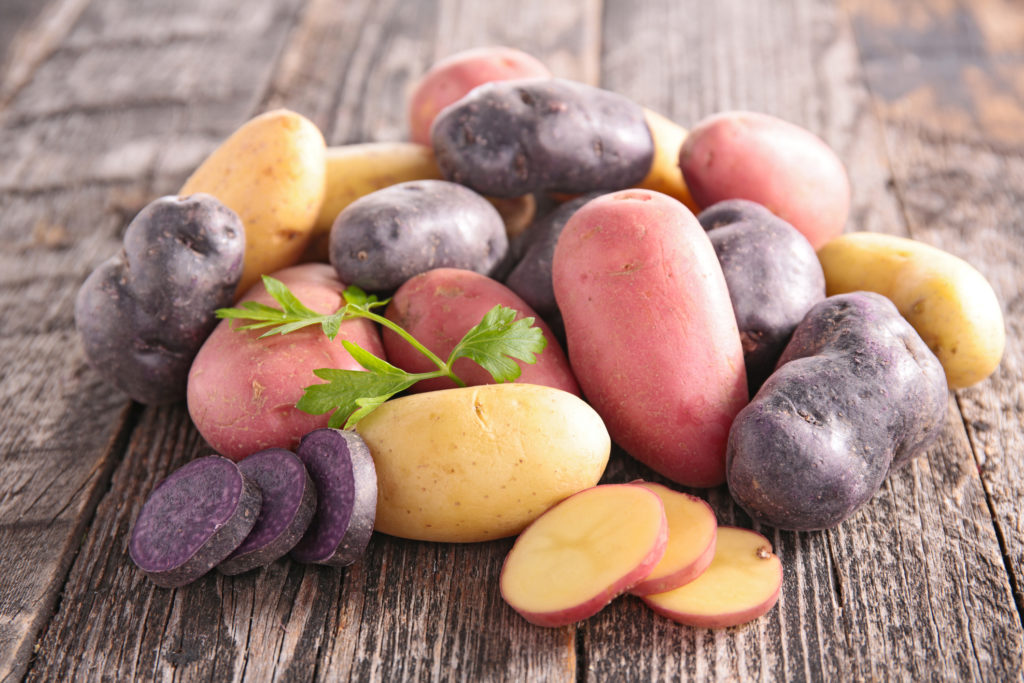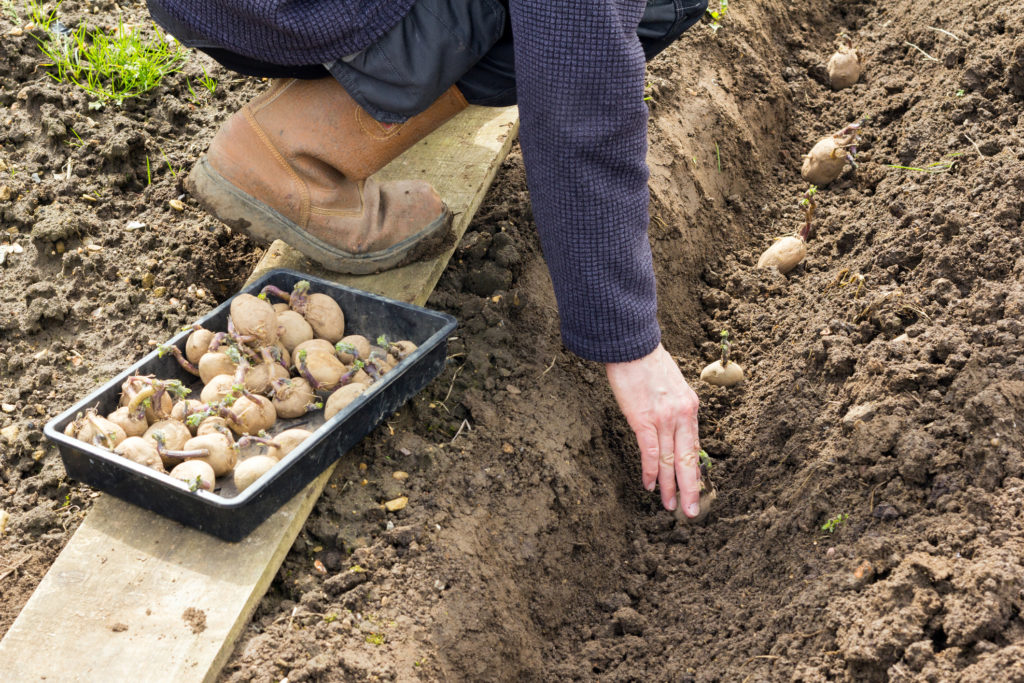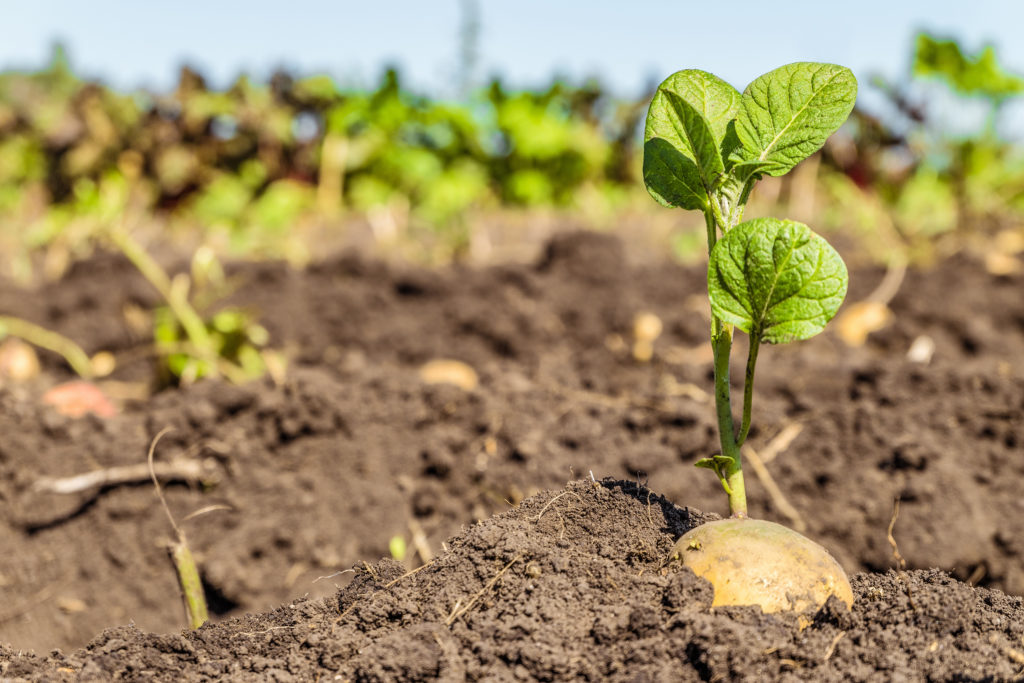
Updated: April 3, 2025
Potatoes are popular vegetables grown for their nutritious underground tubers. Harvested fresh from the garden, they are full of flavor and versatile in cooking. Potatoes are nutritionally high in vitamin C, potassium, fiber, and protein, all with no fat. The skin of the potato contains the majority of the potatoes fiber and many of the nutrients are located close to the skin. Follow this potato growing guide and you will see potatoes are easy to grow as long as they have full sun, moderate temperatures, and light, rich, acidic, well-drained soil. Try some of the many varieties with unique colors, shapes, sizes, and flavors you won’t find in the supermarket.
Types of Potatoes

There are two types of potatoes, common potatoes (also called Irish potato) and sweet potatoes. Potato varieties vary by season, color, texture, use, and storage life. The main types of potatoes are:
- Red Skinned – These potato varieties have thin skin and white flesh. These tubers are all-around varieties that can be used for almost any purpose. Excellent for frying and potato salad. Examples include Red Norland and Red Pontiac.
- Russeted – have a dry and fluffy texture when cooked, and are commonly used for baking and mashed potatoes. An example is Gold Rush.
- Yellow Fleshed – have a flesh color ranging from light to dark yellow. They generally have a creamy and moist texture great for baking, roasting, and mashed potatoes. Examples include German Butterball, Pinto Gold, Redgold, and Yukon Gold.
- White Fleshed – have thin skin and a sweet, mild flavor ideal for mashed potatoes, grilling, and baking. Examples include Superior and Kennebec.
- Fingerling – early maturing types that produce elongated tubers with a firm, dry texture. An example includes Fingerling. Sometimes called salad potatoes.
- Novelty – novelty varieties include those with unusual colored skins and/or flesh. Examples include Magic Molly, with purple skin and flesh, and Huckleberry Gold, with purple skin and buttery-gold flesh.
Potato Planting Tips

pH Level
Potatoes prefer a well-drained, deeply worked soil that is a bit on the acid side with a pH between 5.5 and 6.0. A pH above 6.0 may result in an increase of common scab disease on the tubers.
Soil Temperature for Potatoes
Ideal temperatures for growing potatoes are 65 to 80 degrees F during the day and 55 to 65 degrees F at night. Do not plant seed potatoes until soil temperature reaches 45 degrees F. We recommend a soil temperature of 55 degrees F. to be on the safe side. If soil is cold and wet, the seed may decay, and if it is cold and dry, sprouting may be delayed.
Best Fertilizer for Growing Potatoes
Potatoes like a soil that is well-balanced in nutrients. They are moderate feeders that benefit from regular fertilization. Use full rates of Jung Potato Food 15-15-15, ALGOplus All Purpose 6-6-6 Liquid Fertilizer, or Neptune Fish & Seaweed Fertilizer 2-3-1 for the best fertilizer for growing potatoes.

Potato Spacing
Row spacing can be as close as 2’ where space is limited, but we recommend 3’ between rows to allow adequate space for vines to grow and enough room for hilling for potato growing. Dig a shallow trench 6″ to 8″ deep and place the seed pieces about 12″ to 15″ apart in the row. Cover the seed pieces with about 3” of soil. Fill the trench gradually as the vines grow, covering the stems gradually, once they have emerged from the soil. This is referred to as “hilling”, which we’ll discuss more in a bit.
Bale Gardening Method
An alternative method for growing potatoes is to plant seed pieces shallowly into the soil and cover with a thick layer of clean straw or other weed-free mulch. Add more mulch as needed to keep light from reaching potatoes (a foot or more of mulch may be required). Tubers grown this way can be easily harvested by pulling back the mulch after the plants die. This is similar to the Bale Gardening method.
Potato Maintenance

Hilling Potatoes
To ensure good tuber production, “hill” the potatoes when plants are 8 to 10 inches tall by mounding the soil 3 to 6 inches high and out 12 to 15 inches from the stems. Be careful to avoid damaging the roots, which may extend 8 to 12 inches from the plants. Any tubers not completely covered by soil will turn green and become inedible, so hilling helps to protect the tubers from greening. Soil can be hilled up to 3 inches from the top of the plants.
Watering
In general, 1 inch of water per week by rainfall or irrigation is sufficient. Sandy soils will require more. The root systems are aggressive and usually, find enough water. However, periods of dry soil alternating with periods of wet soil can result in poor quality tubers, so even soil moisture levels should be maintained.
Common Problems with Growing Potatoes
Potatoes are usually not difficult to grow but can suffer from some pest and disease problems. Potatoes may be attacked by leafhoppers or wireworms, and the Colorado Potato beetle can cause severe damage. Common scab can be a problem if soil pH is above 6.0, and late blight disease can also occur. Use Bonide Fung-Onil Fungicide or Serenade Organic Fungicide to prevent late blight infection. Use Colorado Potato Beetle Beater to help control Colorado potato beetles and other insect pests.
Other Recommended Reading

- Companion Planting Guide
- Prevent 4 Common Potato Plant Problems
- 11 Potatoes To Plant On Good Friday
- Understanding Plant Diseases

At Jung Seed Co, we strive to be your go-to guide for all your gardening needs. Our YouTube channel The Garden Doctor by Dick Zondag is where he provides gardening tips for all levels of gardeners. When you need reliable gardening advice, turn to the trusted experts at Jung.
View our new catalog online or browse our website for your gardening favorites. To receive info on new products, exclusive deals, and specials, be sure to sign up for our weekly email. Join our Facebook page, to discuss all things gardening!